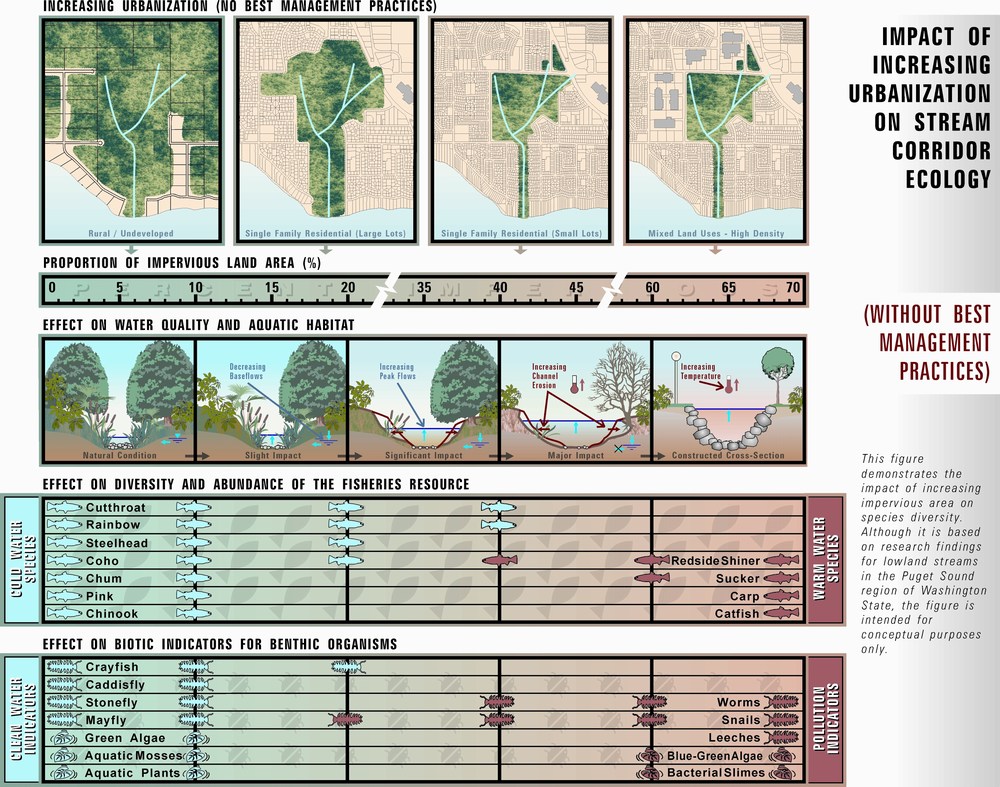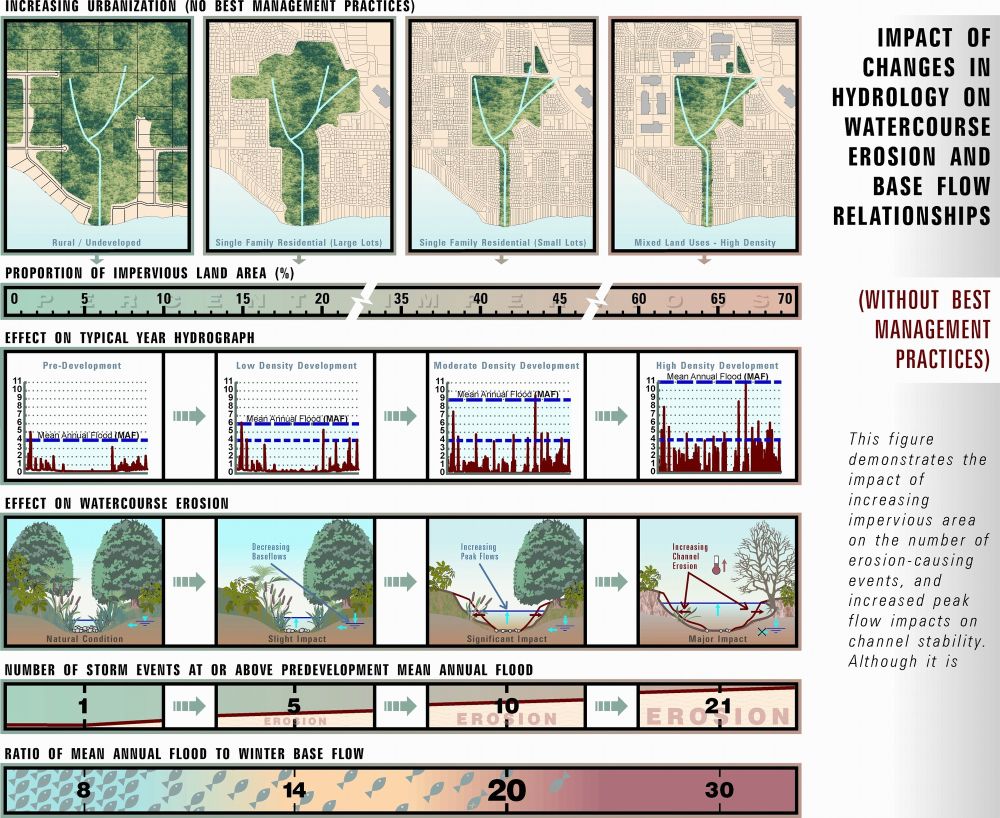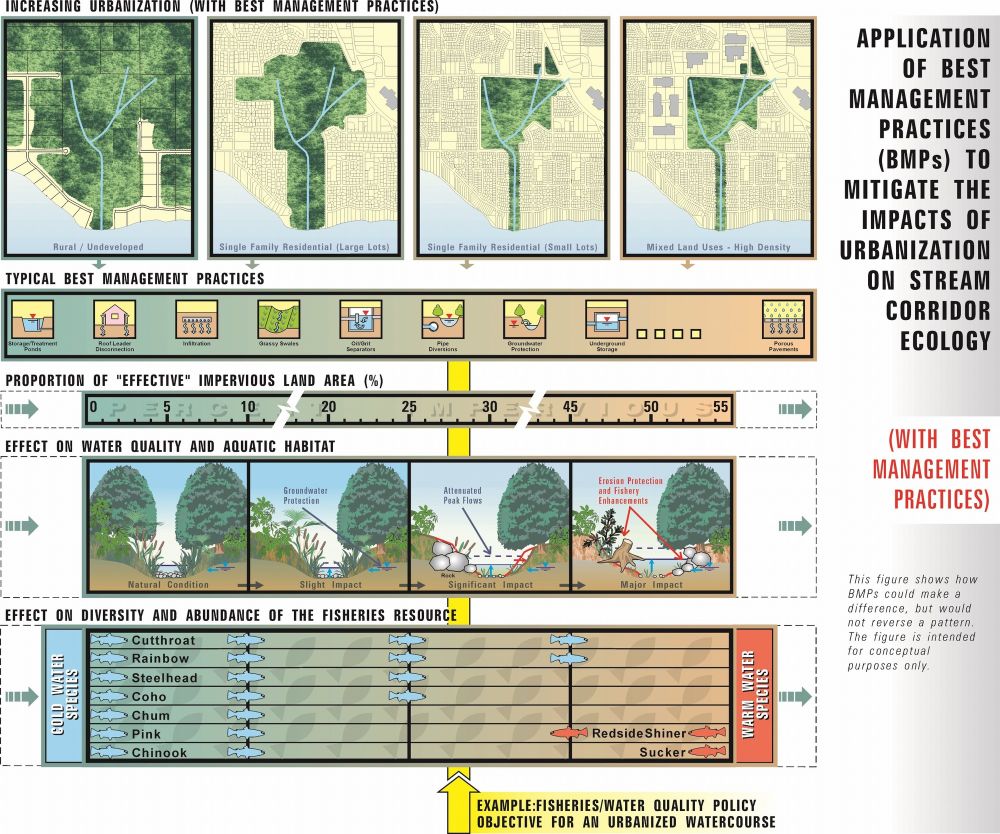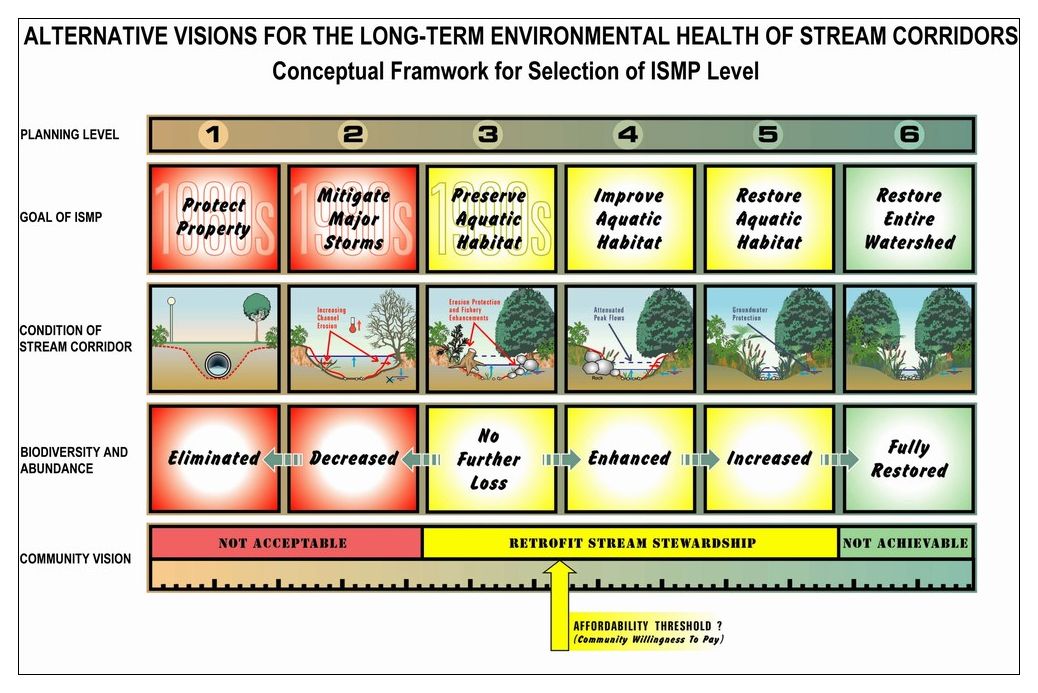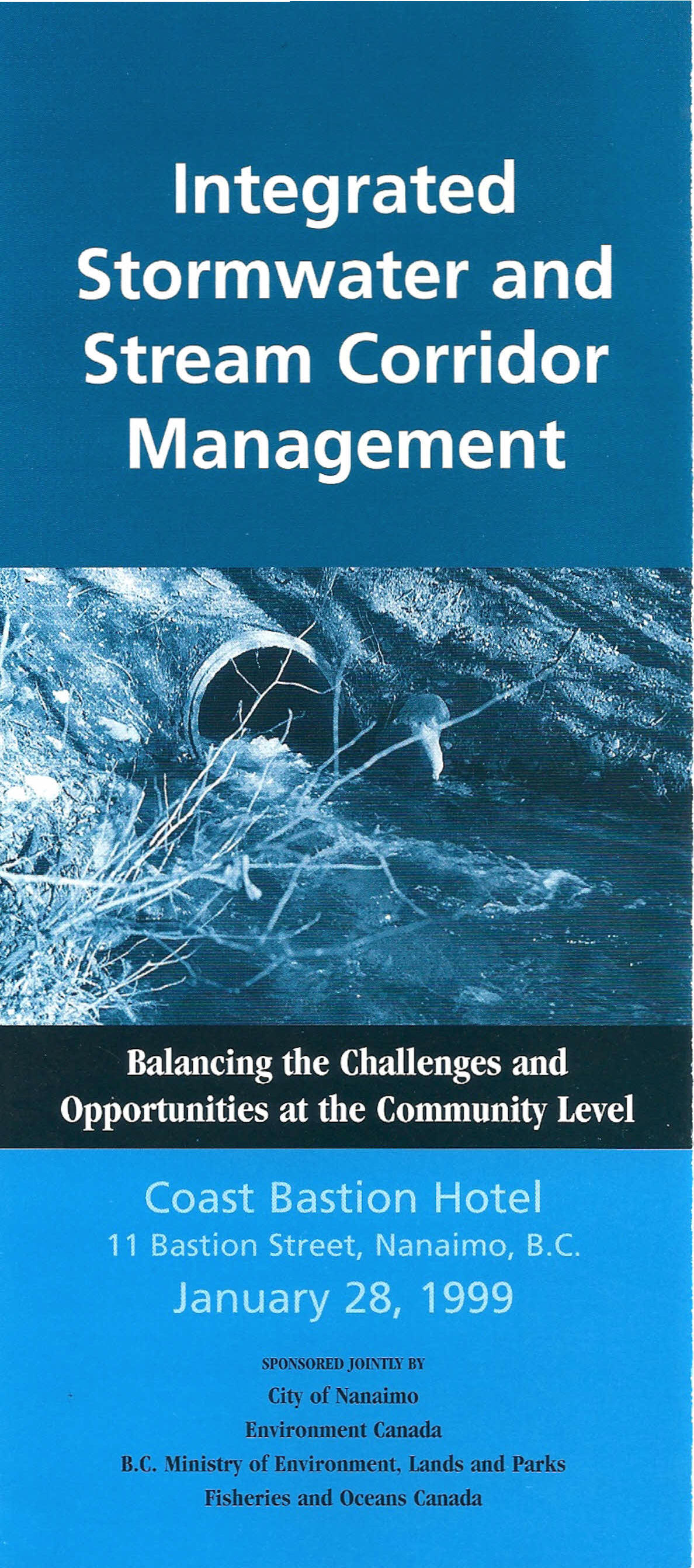RECONNECTING HYDROLOGY & STREAM ECOLOGY IN BRITISH COLUMBIA: Historical context for an ecosystem-based approach to managing land and water in the urban environment – the coming together of a group of change agents in 1997 set in motion a chain of outcomes
Note to Reader:
Two decades ago, the SmartStorm Forum Series comprised events on Vancouver Island (Nanaimo in January 1999) and the Sunshine Coast (Sechelt in September 1999), and in the Fraser Valley (Abbotsford and Pitt Meadows in March 2001).
The genesis for the series was a focus group workshop held in October 1997. Convened by the Union of British Columbia Municipalities (UBCM), the workshop was part of the rollout process for the Fish Protection Act, enacted only a few months before.
The coming together of a group of change agents in October 1997 set in motion a chain of events that has reverberated through time. The SmartStorm Forum Series followed just over a year later; and generated the momentum that ultimately led to incorporation of the Partnership for Water Sustainability as a non-profit society on November 19, 2010.
In parallel with the SmartStorm Forum track, the provincial government also initiated the Water Conservation Strategy for British Columbia in 1997. Both were ‘top-down & bottom-up’ initiatives and were early examples of on-the-ground groundswells informing and influencing provincial policy through shared responsibility.
The two tracks merged with release of the Water Sustainability Action Plan for British Columbia in February 2004. In turn, this laid the groundwork for Living Water Smart, British Columbia’s Water Plan which was released in June 2008.
The article below is the first in a series that provide historical context for developments in British Columbia that have influenced an ecosystem-based approach to managing land and water in the urban environment. This first articles describes a transformative workshop hosted by the Union of BC Municipalities in 1997, and introduces what this game-changing event set in motion. Future articles in the series will then elaborate.
The vision for reconnecting hydrology and ecology got an early boost with the 1997 UBCM Focus Group Workshop
Looking back, and in terms of ‘green’ rainwater management and the vision for reconnecting hydrology and ecology, much of what has happened in British Columbia over the past quarter-century can be traced back to October 1997 and who was in the room when the Union of BC Municipalities convened the focus group workshop on the Fish Protection Act.
 At the workshop, Kim Stephens and Bill Derry led a discussion about a ‘science-based’ ecosystem approach to rainwater and stormwater management. Through their work with local governments, Stephens and Derry are recognized as having facilitated a paradigm-shift in British Columbia in the late 1990s.
At the workshop, Kim Stephens and Bill Derry led a discussion about a ‘science-based’ ecosystem approach to rainwater and stormwater management. Through their work with local governments, Stephens and Derry are recognized as having facilitated a paradigm-shift in British Columbia in the late 1990s.
They achieved this by translating the emerging Washington State science into a set of communication graphics. This approach enabled a common understanding among broad and diverse audiences about the impacts of urbanization on stream health. This helped local governments make informed decisions about urban watershed planning.
The provincial government recognized the value and the power of their work. In mid-1997, the Fish Protection Act was newly enacted. Implementation had encountered resistance from local government, in large part because the legislation introduced the first provincial requirements for streamside protection. The resistance was founded in the perception that streamside protection would constrain land development.
Glen Carlson and Erin Stoddard of the Ministry of Environment invited Kim Stephens and Bill Derry to ‘share the science’ at a crucial focus group workshop involving provincial and local government staff. The workshop preceded a conclave of local government elected representatives and provincial staff.
With the perspective of time, it is clear that the conclave was effectively a conflict resolution session. Hence, there was a sense of urgency and heightened expectation in communicating science-based understanding of the relationship between salmon survivability and the scale of land use change. Overshadowing all was the ‘salmon crisis’ on both sides of the BC-Washington border. At that time, for example, Coho salmon had been designated as an endangered species in Washington State.
“Looking back, British Columbia’s Fish Protection Act was both a defining moment and a call to action. The consultation process led directly to the SmartStorm Forum Series. Guided by a vision for an ecosystem-based approach to land and water development, the series set in motion a chain of events. Their outcomes reverberated and have rippled through time,” reflected Kim Stephens.
Science-Based Ecosystem Approach
“In the 1980s, Bill Derry was one of the first stormwater utility managers in Washington State. In 1988 he co-founded the APWA Stormwater Managers Committee and was co-chair for 20 years. This committee was the primary source of technical advice and review for writing Washington State stormwater regulations and the State’s stormwater technical manual,” explained Kim Stephens.
“Bill Derry believed so strongly in the need for scientifically-defensible research that he convinced his fellow utility managers to organize and fund a research centre at the University of Washington. He was a founding director of the Center For Urban Water Resources Management led first by Richard Horner, and later by Derek Booth.”
“Bill’s committee framed eight key questions. These then defined areas of research by graduate students under the guidance of Dr. Richard Horner. Chris May then pulled together this original research in his PhD dissertation. Early access to the findings in 1996 allowed Bill and me to create what became known as the ‘fish pictures’. These graphics translated the science and set the stage for British Columbia to incrementally move towards sustainable watershed asset management over a period of decades.”
“I remember clearly the moment that the idea for the fish pictures crystallized. Bill Derry and I had flown back from Kelowna and he had an extended wait for his connecting flight back to Seattle. So we sat down at a table and began to sketch out how we could communicate the University of Washington research findings. My takeaway task was to actually create the graphics. The rest is history as they say.”
“The first graphic was the hardest. Once created, we had a foundation that we could build upon as our communication strategy took shape. Ultimately, the series comprised more than a half-dozen graphics which we described as decision support tools. It was all about illustrating the consequences of the choices that we make, and that different choices result in different outcomes – for better of worse.”
The Fish Pictures:
Click on the images to download higher resolution versions. The ‘fish pictures’ are incorporated in Stormwater Planning: A Guidebook for British Columbia. Download a copy of the Guidebook to learn more,
For change to occur, it is all about the Right People being in the Right Place at the Right Time
Erik Karlsen and Peter Law were in the room on that day in October 1997 at the Richmond offices of UBCM. The idea for the first workshop in what became the SmartStorm Forum Series originated with Erik Karlsen, then with the Ministry of Municipal Affairs. Peter Law of the Ministry of Environment embraced the idea and got the ball rolling. He formed and chaired an inter-agency team to organize the inaugural event in what became known as the SmartStorm Forum Series.
The duo of Erik Karlsen and Peter Law had a leadership role in an inter-ministry approach to the development of the streamside protection regulations.
Another key player in the room that day was Dipak Basu, an engineer with the City of Chilliwack.
Watersed/Landscape-Based Approach to Community Planning
 The late Erik Karlsen (1945-2020) was a visionary. In 1994, he conceived and brought the idea of a Georgia Basin Initiative to fruition. Erik led a small team of five which included MLA Joan Sawicki, parliamentary secretary to Minister of Municipal Affairs Darlene Marzari. Joan Sawicki went on to become Minister of Environment (1996-2000). “We were a small group but, with Erik’s energy and access to just about everybody everywhere, he created the illusion of something much larger,” recalled Joan Sawicki at Erik’s retirement party in 2001.
The late Erik Karlsen (1945-2020) was a visionary. In 1994, he conceived and brought the idea of a Georgia Basin Initiative to fruition. Erik led a small team of five which included MLA Joan Sawicki, parliamentary secretary to Minister of Municipal Affairs Darlene Marzari. Joan Sawicki went on to become Minister of Environment (1996-2000). “We were a small group but, with Erik’s energy and access to just about everybody everywhere, he created the illusion of something much larger,” recalled Joan Sawicki at Erik’s retirement party in 2001.
Erik Karlsen conceived and championed the idea of a Watershed/Landscaped-Based Approach to Community Planning. His last assignment while in government was to collaborate with a Metro Vancouver interdisciplinary working group to produce the conceptual framework for the approach. Released in 2002, the document was developed under the umbrella of the Regional Planners Advisory Committee. The underpinning premise is that resource, land use and community design decisions will be made with an eye towards their potential impact on the watershed.
 Stormwater Planning: A Guidebook for British Columbia is a prime application of the ‘watershed/landscape-based’ approach. Peter Law was Chair of the Stormwater Guidebook Steering Committee, an inter-agency group formed in 2000 only a matter of months after the second in the SmartStorm Series. The Guidebook’s premise that land development and watershed protection can be compatible represented a radical shift in thinking in 2002.
Stormwater Planning: A Guidebook for British Columbia is a prime application of the ‘watershed/landscape-based’ approach. Peter Law was Chair of the Stormwater Guidebook Steering Committee, an inter-agency group formed in 2000 only a matter of months after the second in the SmartStorm Series. The Guidebook’s premise that land development and watershed protection can be compatible represented a radical shift in thinking in 2002.
To Learn More About Erik Karlsen:

How the idea for a workshop in Nanaimo morphed into a forum and launched an inter-regional series
“I recall quite clearly that Erik Karlsen and Peter Law were sitting together against the wall to our right as Bill Derry and I spoke impromptu to the fish pictures. It caught my attention how animated they were as they kept turning to each other during Bill and my presentation. Erik and Peter were beaming. When we finished, Erik was the first to speak,” recalled Kim Stephens. “At last,” he said, “we have the science that explains the relationship between changes in land use and the consequences for stream health.”
“Little did I realize in the moment that my life was about to change. Nor did I realize how profoundly Erik Karlsen would influence my career direction. While Bill and I were presenting the fish pictures, Erik was planting seeds with Peter to organize a workshop event on Vancouver Island. Afterwards, they came up to Bill and me and said we have an idea for a workshop that we would like you to lead. Fast forward to January 1999. The SmartStorm Forum Series was launched when the inaugural event was held in Nanaimo and the word resonated beyond Nanaimo.”
“The initial scope was quite modest because we had a limited budget. Then Brian Tutty of the Department of Fisheries & Oceans joined the organizing committee about two months before the scheduled date of the workshop. Program development was well-advanced when Brian announced that the group was not thinking big enough. He made it clear that he was thinking in terms of target audience and venue. He advocated a bold vision for a transformational event.”
“Instead of holding the workshop for a small group in a meeting room at the Beban Recreational Centre in Nanaimo, let’s go big and move it to the Coast Bastion Hotel and re-brand it as a forum. But we don’t have a budget for the Coast Bastion, said Peter Law. Not to worry, replied Brian. He then pulled out his DFO credit card and simply said we will charge it this. Rest assured, he said, they will come.”
“And come they did. The response to the SmartStorm Forum Series was simply overwhelming. The doors had to be closed when the surge of last-minute registrations reached the 250 seating capacity of the Coast Bastion venue.”
When word spread to the Sunshine Coast and Fraser Valley…
“Brian Tutty’s bold vision morphed into a transformational series once Mayor Barry Janyk of the Town of Gibsons became involved. His high profile involvement added political credibility. Mayor Janyk was the moderator for the last three in the series. He brought energy and connections to other mayors, notably Mayor Al Hogarth of Maple Ridge who championed the idea of twin events north and south of the Fraser River in 2001. Barry Janyk and Al Hogarth were successful in getting buy-in from the Mayors of Pitt Meadows and Abbotsford to be series hosts,” continued Kim Stephens.
 “When we decided to host the second event on the Sunshine Coast, the skeptics asked me who would come to the Sunshine Coast. Well, they did come and they came from far and wide, including a representative of the Ontario Ministry of Environment. We attracted a capacity crowd of some 225 to the local theatre in Sechelt. We attracted comparable crowds in Abbotsford and Pitt Meadows. We created a buzz,” stated Barry Janyk. He served four terms as Mayor of Gibsons.
“When we decided to host the second event on the Sunshine Coast, the skeptics asked me who would come to the Sunshine Coast. Well, they did come and they came from far and wide, including a representative of the Ontario Ministry of Environment. We attracted a capacity crowd of some 225 to the local theatre in Sechelt. We attracted comparable crowds in Abbotsford and Pitt Meadows. We created a buzz,” stated Barry Janyk. He served four terms as Mayor of Gibsons.
Mayor Janyk’s tone-setting presentation in 2001 at the Fraser Valley forums was titled The Political Consequences of Doing the Wrong Thing: Why Elected Officials Must Consider Smart Development.
The SmartStorm Series set in motion a chain of events
The first SmartStorm Forum was held in 1999; the last two in March 2001. The kick-off consultation workshop for the Guidebook took place in Nanaimo on February 20, 2001. The SmartStorm Forum Series set in motion the following:
- The SmartStorm Forum Series generated the momentum to develop Stormwater Planning: A Guidebook for British Columbia, released in mid-2002;
- which begat the Water Balance Model for British Columbia, completed in 2003;
- which led to a knowledge-sharing session with elected representatives at the 2003 UBCM Annual Convention;
- which provided early credibility for the Water Sustainability Action Plan for BC, launched in early 2004;
- which led to the formation of the BC Green Infrastructure Partnership, launched in early 2004;
- which then laid the groundwork for the success of Convening for Action on Vancouver Island, launched in late-2006; and
- culminated with incorporation of the Partnership for Water Sustainability in British Columbia as a non-profit society on November 19, 2010.
When the SmartStorm Forum Series introduced the term ‘smart development’ in 1999 the goal was to advance implementation of an integrated and balanced approach to land use. It was Mayor Janyk who coined the term ‘Smart Development’ to clearly differentiate the BC approach from the Low Impact Development terminology used in the United States.
“To change the way people think and do, we defined smart development as protecting property and sustaining natural systems in a cost-effective manner,” stated Mayor Janyk. “We made it clear that RAINwater management is at the heart of smart development. Whereas traditional STORMwater management is based on end-of-pipe solutions, a smart approach starts at the source – where rain falls.”
Guidance for an Ecosystem-based Approach
The inter-agency organizing committee for the Nanaimo SmartStorm Forum included federal, provincial and local government representation. The City of Nanaimo was the event host. The committee published a newsletter as legacy document. It was designed to provide attendees and others with guidance that would help them replace traditional strategies with ones that integrated stormwater management and stream stewardship. This guidance document comprised ‘think pieces’ written by Erik Karlsen, Bill Derry, Kim Stephens and UBC professor Patrick Condon. They were the faculty for the forum.
“The Nanaimo Smartstorm Committee recognized that it would be a balancing act to protect property and allow economic land use, while at the same time attempting to achieve the goal of sustaining natural systems in stream corridors. In 1999, we clearly understood that a strategy must be watershed-based to fulfil a set of guiding principles. We also recognized that this would require integration of component plans for flood risk management and environmental risk management for life/property protection and for stream bank/habitat protection, respectively. A generation ago, this represented a major departure from the traditional engineering approach,” explained Kim Stephens.
To Learn More:
Download a copy of Integrated Stormwater & Stream Corridor Management, released in January 1999.
Download a copy of Overview of Workshop Objectives for Integrated Stormwater & Stream Corridor Management.
Programs for the SmartStorm Series
The two Fraser Valley forums built on the momentum and lessons learned from the previous Vancouver Island and Sunshine Coast forums.
To Learn More:
To learn more about the program content for each event in the SmartStorm Forum Series, click on the following links to access the brochures:
- 1999 Nanaimo brochure: Integrated Stormwater & Stream Corridor Management
- 1999 Sunshine Coast brochure: Smart Development & Stormwater Management
- 2001 Fraser Valley brochure: Smart Development & Stormwater Management
From the introduction to the Sunshine Coast brochure: “The realization in the early 1970s that upstream activities have downstream impacts was a breakthrough in drainage planning. ..Two decades later, concern for the environment has led to another turning point…..Understanding how to collaborate with other disciplines to align roles and responsibilities is key to mitigating both flood hazard and environmental risks, and making science-based strategies a reality.”
2003 UBCM Urban Forum
Mayor Janyk also led the 3-person team that delivered the Water Balance Model program at the 2003 UBCM Urban Forum. Designed to inform and educate elected representatives, the program was structured in five parts. Mayor Janyk delivered the opening and closing segments. The other two members of the presentation team were Dipak Basu of the City of Chilliwack and Kim Stephens.
To Learn More:



